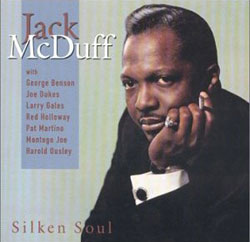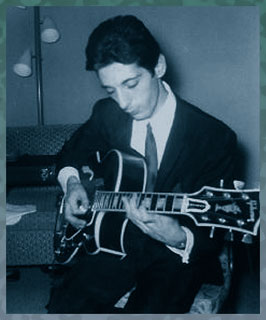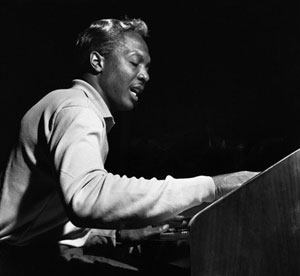

|
Soundclip:
|
| See Steve's Hand-Written Solo
Transcription |
|
Pat Martino's solo on: "How High The Moon"(Lewis-Hamilton) Usually I can begin any analysis with a bit of historical data, or a story or two, but, with the recordings that this particular Pat Martino solo appears on, first as the Brother Jack McDuff LP, "I GOT A WOMAN"(Prestige), and now as part of the CD compilation, "SILKEN SOUL"(Prestige) which features: both Harold Ousley(Tenor Sax) & Red Holloway(Tenor Sax), and Joe Dukes(Drums), the information supplied on both sets of liner notes tell us nothing about the precise recording information. We only learn that these sessions took place in New York between 1964-65, and that's all. There are no engineering credits whatsoever.  We do learn that the original sessions were produced by Lew Futterman. To put this into perspective, Pat Martino, who did record a few LPs as a sideman under his given name of Pat Azzara, was about 20 years old when he did this session with Jack McDuff!!! And about a year later, he would record his first album as a leader, "EL HOMBRE" for Don Schlitten's Prestige label. We do learn that the original sessions were produced by Lew Futterman. To put this into perspective, Pat Martino, who did record a few LPs as a sideman under his given name of Pat Azzara, was about 20 years old when he did this session with Jack McDuff!!! And about a year later, he would record his first album as a leader, "EL HOMBRE" for Don Schlitten's Prestige label.This performance of the oft-played and recorded "How High the Moon" is played at, what I would describe as, a brisk organ trio 'jump' tempo, propelled by Joe Dukes with his hi-hat closing on 2 & 4, and his cross-stick hitting the snare on beat 4. This particular 32-bar standard falls into the category of tunes with an [A]-[A'] form, with each section containing 16-bars. On the recording, Pat Martino's 2 chorus solo is sandwiched in between tenor sax solos by Ousley first, and then Holloway, all this before leader, McDuff solos. Then the group exchanges 2 shout choruses of 8's between drummer Dukes and the frontline before a reprise of the melody. When you are looking at a set of changes like this, and you see a very basic movement of major7 to minor7 appearing, and back-to-back, one whole-step below: | Fmaj7 / / / | / / / / | Fm7 / / / | Bb7 / Bb7(alt.) / || In the area of G major, you would expect to see key defining notes like B-natural and F#, and as the chord changes to Gm7, you should see those two pitches change to Bb and F-natural respectively. In bar 5 as the tune moves to the area of F major, you would expect to see key defining notes like A-natural and E-natural, and as the chord changes to Fm7, you should see those two pitches change to Ab and Eb respectively. As we go through this Pat Martino solo, we're going to see if this is the case or not. As Chorus 1 begins, Pat's first note is, as one could expect, a B-natural, and in bar 3, as the chord changes to Gm7, we have the appearance of a Bb. Of course, once you have shifted from G major [G, A, B, C, D, E, F#] to G Dorian [G, A, Bb, C, D, E, F], you are already in the key of F major. So, in bar 4, the arpeggiated vault, Bb-D-F to A-natural for the arrival of Fmaj7 is easy enough to do. As bar 7 arrives, it is anticipated by a rather typical Martino form of chromaticism over any major 7th chord, as he descends chromatically from the major 7th(E-natural) to the the 5th(C). From there, the key note of Ab appears, and you know that the chord has changed to Fm7. Theoretically, he is applying F Dorian [F, G, Ab, Bb, C, D, Eb]. If one is a beginner, and is trying to get a feeling for playing over these kinds of changes, you could do worse than to memorize these first 8 bars, learning them in 2-3 different registers and several keys. After that, you would have a good framework for expanding your Jazz phrasing vocabulary. Over the years, players have treated the changes to this tune and letter [A] in a wide variety of ways, and bar 11 is usually interpreted as Gm7, but, some players choose to play Gmaj7 there.  Bars 9-16 are a turnaround, and could be played any number of ways. In Chorus 1, you can clearly hear that McDuff plays A7 in bar 15, and C/D in bar 16. On beats 3-4 of bar 16, Martino plays a very characteristic phrase, with the 8th-note/two 16th-note phrasing not to be overlooked, accentuating the b9(Eb) and #9(F-natural) of D7 to turn the harmony back around, and resolve to B-natural at the end of the bar, anticipating the arrival of Gmaj7. Bars 9-16 are a turnaround, and could be played any number of ways. In Chorus 1, you can clearly hear that McDuff plays A7 in bar 15, and C/D in bar 16. On beats 3-4 of bar 16, Martino plays a very characteristic phrase, with the 8th-note/two 16th-note phrasing not to be overlooked, accentuating the b9(Eb) and #9(F-natural) of D7 to turn the harmony back around, and resolve to B-natural at the end of the bar, anticipating the arrival of Gmaj7.As [A'] arrives, Pat again uses an ascending line that I view as connected to the blues language, which, begins on the blue note of the #9/m3rd(Bb/A#), and goes up to the 5th(D). He again anticipates the arrival of the Gm7 by hitting a Bb before bar 3 has arrived. In bar 5-6, he plays a typical line configuration for maj7th chords, which always goes: maj7(E)-R(F)-3rd(A)-5th(C), and he repeats this exact arpeggio in the following bar. As the Fm7 is about to arrive, Pat anticipates bar 7 by playing Eb going into the bar, and then the Ab appears and the chordal sound has been defined. In bar 9 of this section, just as he played it in bar 9 of the first [A] section, he plays the same chromatic ascending bluesy phrase, this time over Ebmaj7. During the turnaround of this section, in bar 15, you see the same 8th-note/two 16th-note mannerism with the b9(Eb) and #9(F-natural) of D7. This time, he resolves to G major in bar 16, which heralds the arrival of Chorus 2. Martino's Chorus 2 begins with a great example of riding a single note, or riffing on a note or phrase, in this case a G-natural, that can be found in the chord scales or the modes for each of the chords within bars 1-6. To me, this is a huge part of the blues tradition, but certainly a rich part of the great organ trio format as well. In bar 7, he emerges from that G-natural, and, by observing the arrival of the Fm7 chord where, again, you clearly see Eb and Ab serving to define this chord change. In bar 8, he uses the Bb7 alterations of Cb(b9) and Gb/F#(#5), as part of an arpeggio, to pull towards resolution at bar 9 and the Ebmaj7 chord. During the turnaround in bars 13-15 of this section, Pat's lines are classic for these kinds of changes especially over the VI7(alt.) chord, E7(alt.). These bars certainly merit study for the younger player. In bar 14, pay special attention to the jump from the 3rd(G#) up to the #9(G-natural), and notice how it descends to the C-natural, the m3rd of Am7. [A'], and the final 16 bars of this solo, gets underway with a descending line that begins on a high E-natural, and considering that the chord is Gmaj7, it's a little curious to see an F-natural placed on beat 3, a rhythmic point of emphasis. As the chord changes to Gm7 in bar 3, Martino walks right up the G Dorian mode from the root with one chromatic passing tone(C#) between C & D. In bar 4, that passing tone is removed.  On beats 3 & 4, you see the repeated note, F-natural, which is played alternating your B-string and G-string which, for the guitarist, gives us a saxophone-like alternate fingering sound. This is a most useful device to have in your arsenal of Jazz tools. It is followed immediately by another most useful device, as part of a triplet figure, he slurs up chromatically from E to G, with all the work being done by the left-hand. One picked stroke is enough! Still over the Fmaj7 chord, bar 6 repeats a phrase that we saw before during [A] of Chorus 1. But here, as he is descending, and the chord changes to Fm7 at bar 7, you then see the all important Ab to acknowledge the change in harmony, major to minor. As Pat heads towards resolution in bar 9 at the Ebmaj7 chord, he prepares for this by playing, over the Bb7(alt.), Cb(b9)-Bb(R)-Ab(7th). And in bar 9, over the Ebmaj7 chord, he plays the exact same blues-based line that he has played two times before in Chorus 1. In bar 11 of the 2nd-half of the chorus, he again applies the same little 4-note gliss or slur technique, but this time it is from the maj7th(F#) up to the 9th(A). In bar 12, as we are headed for a Bm7, a common substitution for Gmaj7, Pat's line, because of the presence of both Eb and Bb, seems to indicate that he was thinking of Cm7, and being 1/2-step above where he was headed. This is another common linear device when improvising. As the solo nears its end, in bar 14, you see a nice ii-V phrase over Am7-D7 that offers the alteration of the b9(Eb) as he's headed for Gmaj7. The final line over Gmaj7 begins in the exact same way that the line in bar 9, over Ebmaj7 began, just down a 6th. Finally, as he tails-off into what will be the first bar of the 2nd tenor sax solo, he walks down from D-natural to a B-natural employing a marked decrescendo in volume. Dynamics!!! This reminds me of the very tired musician's joke where one player says to another, perhaps a guitarist, something like this: "Hey man, you should think about dynamics more often! And the response is: "You must be kidding man, I'm playing as loud as I can!" On beats 3 & 4, you see the repeated note, F-natural, which is played alternating your B-string and G-string which, for the guitarist, gives us a saxophone-like alternate fingering sound. This is a most useful device to have in your arsenal of Jazz tools. It is followed immediately by another most useful device, as part of a triplet figure, he slurs up chromatically from E to G, with all the work being done by the left-hand. One picked stroke is enough! Still over the Fmaj7 chord, bar 6 repeats a phrase that we saw before during [A] of Chorus 1. But here, as he is descending, and the chord changes to Fm7 at bar 7, you then see the all important Ab to acknowledge the change in harmony, major to minor. As Pat heads towards resolution in bar 9 at the Ebmaj7 chord, he prepares for this by playing, over the Bb7(alt.), Cb(b9)-Bb(R)-Ab(7th). And in bar 9, over the Ebmaj7 chord, he plays the exact same blues-based line that he has played two times before in Chorus 1. In bar 11 of the 2nd-half of the chorus, he again applies the same little 4-note gliss or slur technique, but this time it is from the maj7th(F#) up to the 9th(A). In bar 12, as we are headed for a Bm7, a common substitution for Gmaj7, Pat's line, because of the presence of both Eb and Bb, seems to indicate that he was thinking of Cm7, and being 1/2-step above where he was headed. This is another common linear device when improvising. As the solo nears its end, in bar 14, you see a nice ii-V phrase over Am7-D7 that offers the alteration of the b9(Eb) as he's headed for Gmaj7. The final line over Gmaj7 begins in the exact same way that the line in bar 9, over Ebmaj7 began, just down a 6th. Finally, as he tails-off into what will be the first bar of the 2nd tenor sax solo, he walks down from D-natural to a B-natural employing a marked decrescendo in volume. Dynamics!!! This reminds me of the very tired musician's joke where one player says to another, perhaps a guitarist, something like this: "Hey man, you should think about dynamics more often! And the response is: "You must be kidding man, I'm playing as loud as I can!"Perhaps because he was so very young when this was recorded, and we really know nothing about the circumstances of the actual recording session, I would not say, by any means, that this is a classic Pat Martino solo. But, it certainly offered a glimpse into the very polished player he was to become, and just a short time later. All this would indicate that there is no greater teacher than being on the bandstand, and playing live as much as is possible. For those of you who are just coming to discover this great artist, because of its relative simplicity and the repetition of certain ideas, phrases, this might not be a bad solo to start with. Just a thought!
[Photo of Pat Martino by: Joe Carola ca. 1964
Photo of Jack McDuff ca. 1975] |